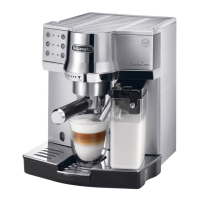19
12.3 Steam
1. Make sure the hot water spout (C7) is attached correctly
(g. 6);
2. Fill a container with the liquid to be heated or frothed and
immerse the steam spout in the liquid;
3. Press the button (B7). The corresponding light ash-
es and the appliance starts delivering steam;
4. When the required temperature is reached, stop steam
delivery by pressing the same button. STEAM SHOULD
NOT BE GENERATED BY THE MACHINE FOR MORE THAN 3
MINUTES CONTINUOUSLY.
Important: Always shut o the steam before the container with the heated liquid is
drawn clear of the spout, as splashes can cause scalding.
12.4 Clean the steam/hot water spout after use
Always clean the spout after use to avoid the build-up of milk
residues and prevent the spout from clogging.
1. Place a container under the water/steam spout (C7) (g.
7) and press the button (B7) to deliver a little water;
2. Stop the ow of hot water by pressing the button
again;
3. Wait a few minutes for the hot water/steam spout to cool
down, then extract the hot water spout;
4. Turn the cappuccino maker anticlockwise and extract down-
wards (g. 26);
3. Remove the nozzle downwards (
g. 27
);
5. Check the hole in the cappuccino maker is not blocked. If
necessary, clean with a pin;
6. Wash all parts of the spout thoroughly with a sponge and
warm water;
7. Reinsert the nozzle and replace the cappuccino maker on
the nozzle, pushing it upwards and turning it until it is
attached;
8. Reinsert the spout.
13. CLEANING
13.1 Cleaning the machine
The following parts of the machine must be cleaned regularly:
- the appliance’s internal circuit;
- drip tray (A10);
- coee lters (C2), (C3) and (C4);
- boiler outlet (A5);
- water tank (A8);
- milk container (D);
- the hot water spout (C7) as described in section “12.4
CLEAN THE STEAM/HOT WATER SPOUT AFTER USE”;
- the milk container/water spout connector (A2).
Important!
• Do not use solvents, abrasive detergents or alcohol to clean
the coee machine.
• Do not use metal objects to remove encrustations or coee
deposits as they could scratch metal or plastic surfaces.
Danger! While cleaning, never immerse the coee maker in water. It is an elec-
trical appliance.
13.2 Cleaning the internal circuit
If the appliance is not used for more than 3/4 days, before using
it again, we strongly recommend you turn it on and rinse the
internal circuits through as described in points 4 and 5 of section
“3. SETTING UP THE APPLIANCE”.
13.3 Cleaning the drip tray
The drip tray is tted with a level indicator (red) showing the
level of water it contains. Before the indicator protrudes from
the cup tray, the drip tray must be emptied and cleaned, other-
wise the water may overow the edge and damage the appli-
ance, the surface it rests on or the surrounding area.
1. Remove the tray (g. 28);
2. Remove the cup tray (A12), empty the water (g. 29) and
clean the drip tray with a cloth, then reassemble the drip
tray;
3. Put the drip tray back in place.
13.4 Cleaning the coee lters
Clean the coee lters weekly:
1 and 2 cup lters
1. Extract the perforated lter by pulling the tab (g. 30);
2. Rinse the lters under running water (g. 31);
3. Make sure the holes are not blocked. If necessary, clean
with a pin (g. 32);
4. Place the perforated lter in the lter housing and press
as far as it will go.
Pod lter
Rinse under running water. Make sure the holes are not blocked.
If necessary, clean with a pin (g. 32)..
13.5 Cleaning the boiler outlet
After every 200 coees, rinse the boiler outlet (A5) by delivering
about 0.5 l of water from the boiler outlet (press the coee but-
ton without using ground coee).
13.6 Cleaning the water tank
1.
Clean the water tank (A8) regularly (about once a month and
whenever you replace the water softener lter (C10), if pro-
vided) with a damp cloth and a little mild washing up liquid;
2.
Remove the lter (if installed) and rinse with running
water;
3. Replace the lter (if installed), ll the tank with fresh water
and replace;
4. (Models with water softener lter only) Deliver about 100
ml of water.

